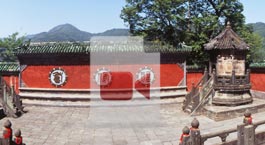History of Qigong
( chinadaily.com.cn )
Updated: 2012-05-22
The practice of Qigong is thought to date back around the dawn of Chinese civilization, as early as the seventeenth century B.C.
Legends of the Shang Dynasty(c.16th century-11the century BC) period describe how members of the ancient Tao Tang tribes would imitate the movements of wild animals in order to dispel rheumatism caused by the cold, damp climate. The exercises, called "Dao Yin", evolved over the centuries into what is now known as Qigong, and reflect the Chinese principle of looking to nature for healing.
From very early times, Qigong was incorporated into Chinese medicine. During the Spring/Autumn Period (770-426 B.C.) and the Warring States Period, (476-221 B.C.) the basic principles of Traditional Chinese Medicine were developed, including the theory of Yin/Yang imbalance as the root cause of illness, the role of the Five Elements (Earth, Water, Air, Fire and Metal), modes of diagnosis (tongue and pulse) and healing (acupuncture, herbs, Qigong and diet). The "three treasures" of the human body, "Qi" or vital energy, "Jing" or life essence, and "Shen" or spirit were viewed as the key to vibrant health."
The Yellow Emperor and the Han Dynasty
The earliest written mention of Qigong as a healing technique is found in The Yellow Emperor's Classic of Internal Medicine, or Huang Ti Nei Jing , written sometime during the Han Dynasty (206 BC-AD 220). Here it describes the fundamental natural principles that lead to good health: "In the past, people practiced the Tao, the Way of Life. They understood the principle of balance, of Yin and Yang, as represented by the transformation of the energies of the universe. Thus, they formulated practices such as Dao-In (Qigong), an exercise combining stretching, massaging, and breathing to promote energy flow, and meditation to help maintain and harmonize them with the universe."
They ate a balanced diet at regular times, arose and retired at regular hours, avoided overstressing their bodies and minds, and refrained from overindulgence of all kinds. They maintained well-being of body and mind; thus, it is not surprising that they lived over one hundred years.
Another early Han period record of Qigong practice is the Dao Yin Illustrations (Dao Yin Tu), written by the healer Hua Tuo, considered the patriarch of Chinese medicine. It includes a chart representing 44 human figures which perform movements emulating wild animals, including the wolf, monkey, bear, crane, hawk and vulture. Hua Tuo is credited with developing the "Five Animal Frolics" style, which is still popular today.
Up until the 20th century, Qigong was a closely-guarded state secret in China, passed down from monk to monk in special "lineages". On demand, the monks would share their esoteric Qigong knowledge with their emperors, who were more often than not seeking the key to eternal life.
As it developed over the centuries, Qigong incorporated a variety of religious influences - Buddhist monks used Qigong to enhance their spiritual practice, strengthen their bodies and help them attain enlightenment (nirvana). Taoists used it to help them become strong and flexible like nature, with the goal of attaining immortality. During the Liang Dynasty, a Buddhist monk named Da Mo would develop two series of exercises to improve the health of the monks living at the Shaolin Temple. These exercises, Muscle/Tendon Changing and Bone/Marrow Washing, are still used today. Due to this influence, Qigong became incorporated into martial arts training.
Today, almost a billion Chinese practice Qigong daily in parks and gymnasiums around China. It is considered a basic health maintenance ritual.



